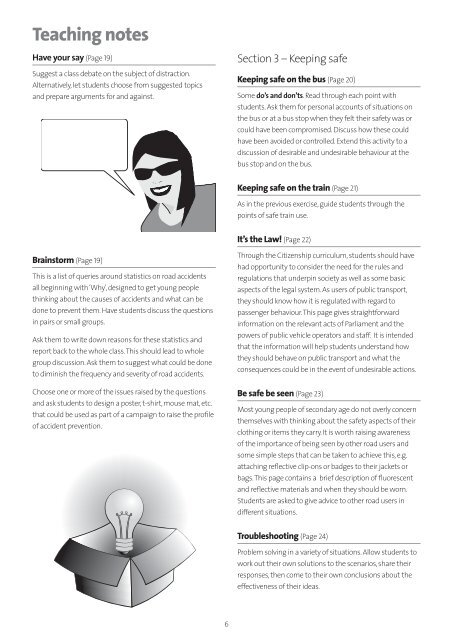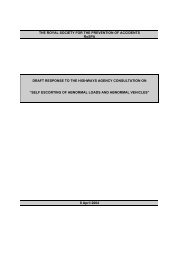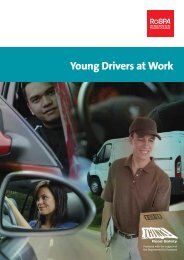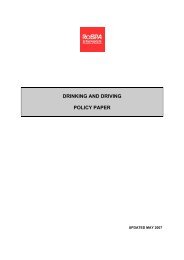Travel training - Key Stages 3 and 4 - RoSPA
Travel training - Key Stages 3 and 4 - RoSPA
Travel training - Key Stages 3 and 4 - RoSPA
Create successful ePaper yourself
Turn your PDF publications into a flip-book with our unique Google optimized e-Paper software.
Teaching notes<br />
Have your say (Page 19)<br />
Suggest a class debate on the subject of distraction.<br />
Alternatively, let students choose from suggested topics<br />
<strong>and</strong> prepare arguments for <strong>and</strong> against.<br />
Section 3 – Keeping safe<br />
Keeping safe on the bus (Page 20)<br />
Some do’s <strong>and</strong> don’ts. Read through each point with<br />
students. Ask them for personal accounts of situations on<br />
the bus or at a bus stop when they felt their safety was or<br />
could have been compromised. Discuss how these could<br />
have been avoided or controlled. Extend this activity to a<br />
discussion of desirable <strong>and</strong> undesirable behaviour at the<br />
bus stop <strong>and</strong> on the bus.<br />
Keeping safe on the train (Page 21)<br />
As in the previous exercise, guide students through the<br />
points of safe train use.<br />
It’s the Law! (Page 22)<br />
Brainstorm (Page 19)<br />
This is a list of queries around statistics on road accidents<br />
all beginning with ‘Why’, designed to get young people<br />
thinking about the causes of accidents <strong>and</strong> what can be<br />
done to prevent them. Have students discuss the questions<br />
in pairs or small groups.<br />
Ask them to write down reasons for these statistics <strong>and</strong><br />
report back to the whole class. This should lead to whole<br />
group discussion. Ask them to suggest what could be done<br />
to diminish the frequency <strong>and</strong> severity of road accidents.<br />
Choose one or more of the issues raised by the questions<br />
<strong>and</strong> ask students to design a poster, t-shirt, mouse mat, etc.<br />
that could be used as part of a campaign to raise the profile<br />
of accident prevention.<br />
Through the Citizenship curriculum, students should have<br />
had opportunity to consider the need for the rules <strong>and</strong><br />
regulations that underpin society as well as some basic<br />
aspects of the legal system. As users of public transport,<br />
they should know how it is regulated with regard to<br />
passenger behaviour. This page gives straightforward<br />
information on the relevant acts of Parliament <strong>and</strong> the<br />
powers of public vehicle operators <strong>and</strong> staff. It is intended<br />
that the information will help students underst<strong>and</strong> how<br />
they should behave on public transport <strong>and</strong> what the<br />
consequences could be in the event of undesirable actions.<br />
Be safe be seen (Page 23)<br />
Most young people of secondary age do not overly concern<br />
themselves with thinking about the safety aspects of their<br />
clothing or items they carry. It is worth raising awareness<br />
of the importance of being seen by other road users <strong>and</strong><br />
some simple steps that can be taken to achieve this, e.g.<br />
attaching reflective clip-ons or badges to their jackets or<br />
bags. This page contains a brief description of fluorescent<br />
<strong>and</strong> reflective materials <strong>and</strong> when they should be worn.<br />
Students are asked to give advice to other road users in<br />
different situations.<br />
Troubleshooting (Page 24)<br />
Problem solving in a variety of situations. Allow students to<br />
work out their own solutions to the scenarios, share their<br />
responses, then come to their own conclusions about the<br />
effectiveness of their ideas.

















